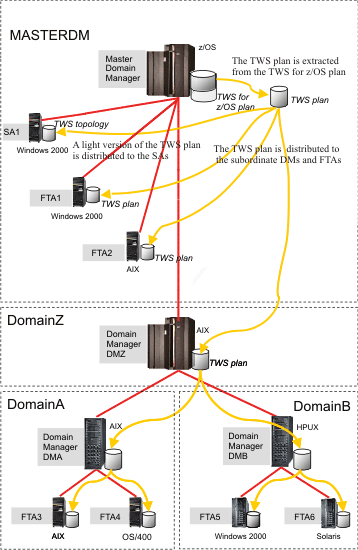End-to-end scheduling with fault tolerance capabilities
Learn about End-to-end scheduling with fault tolerance capabilities.
End-to-end scheduling with fault tolerance capabilities directly connects HCL Workload Automation standard agents, fault-tolerant agents, and domain managers (with their underlying agents and domains) to IBM Workload Scheduler for z/OS. IBM Workload Scheduler for z/OS is seen by the distributed network as the master domain manager.
IBM Workload Scheduler for z/OS creates the production plan also for the distributed network and sends it to the domain managers and to the directly-connected agents. The domain managers send a copy of the plan to each of their agents and subordinate domain managers for execution.
The HCL Workload Automation domain managers function as the broker systems for the distributed network by resolving all dependencies for their subordinate managers and agents. They send their updates (in the form of events) to IBM Workload Scheduler for z/OS so that it can update the plan accordingly. IBM Workload Scheduler for z/OS handles its own jobs and notifies the domain managers of all the status changes of the IBM Workload Scheduler for z/OS jobs that involve the HCL Workload Automation plan. In this configuration, the domain managers and all the distributed agents recognize IBM Workload Scheduler for z/OS as the master domain manager and notify it of all the changes occurring in their own plans. At the same time, the agents are not permitted to interfere with the IBM Workload Scheduler for z/OS jobs, because they are viewed as running on the master that is the only node that is in charge of them.
In the IBM Workload Scheduler for z/OS current plan, you can specify jobs to run on workstations in the HCL Workload Automation network. IBM Workload Scheduler for z/OS passes the job information to the Symphony® file in the IBM Workload Scheduler for z/OS server, which in turn passes the Symphony file to the HCL Workload Automation domain managers (DMZ) to distribute and process. In turn, HCL Workload Automation reports the status of running and completed jobs back to the current plan for monitoring in the IBM Workload Scheduler for z/OS engine.
